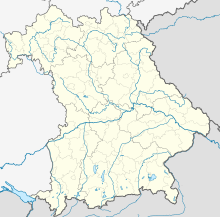Army ammunition facility in Straß
Coordinates: 48 ° 25 ′ 2 ″ N , 10 ° 10 ′ 0 ″ E
The Heeresmunitionsanstalt Straß (short: Muna Straß ) in Straß , a district of Nersingen, was an ammunition plant for the production of ammunition and a warehouse for ammunition, V2 rockets and chemical weapons in the Second World War . From 1951 the area served the US armed forces as a training area and later parts of the newly founded Bundeswehr as a mobilization base. Military use is discontinued.
location
The site of the former ammunition plant is strategically located not far from the railway line from Ulm to Augsburg in the Klassenhartwald forest between Straß , Fahlheim and Bibertal . The forest afforded privacy against aerial reconnaissance and nearby Leipheim was a military airfield of the Air Force . The facility originally extended over 186 hectares and comprised 20 km of roads and railways .
Second World War
In infantry ammunition bearing, Pioneer ammunition and artillery ammunition up to caliber 64 cm laboring and stored. Ammunition captured by foreign troops was sorted and used cartridges and shell casings were processed for reuse. Four bunkers contained poison gas ammunition with the chemical warfare agents white cross , blue cross , green cross and yellow cross . Because of the dangerous nature of the toxins, there was an evacuation plan for the surrounding communities. From 1943, a top secret storage area for V2 rockets was added on a 40 hectare area . On average, several ammunition trains with 20 wagons each left the institution each week .
In April 1945, American air raids on the Muna took place over two days in order to destroy the V2 camp. When the American ground troops approached, the administration building and the V2 rockets were destroyed by the Wehrmacht . Major Jürgens and his adjutant handed over the bunker with the poison gas ammunition to the advancing Americans on April 23, 1945 on the orders of the OKW . If there had been fighting, something bad could have happened here.
post war period
Military use

Soon afterwards the Americans transported the poison gas ammunition in a train with 30 wagons across the destroyed Germany to Bremerhaven . From there it was - as was common at the time - probably sunk in the North Sea. By 1947, the Americans blew up any ammunition found on site and transported the large calibers away. Case cleaning machines were brought to France. In 1947 a German company was commissioned with the disposal of the ammunition and the decontamination of the site. In that year, 285 people were reported within 3 weeks because they were looking for usable items on the site during these years of need. In 1953 the area was systematically cleared of explosives.
In September 1952, the American military established a training area on an area of 110 hectares, on which in the 1980s nuclear- armed Pershing II missiles were set up at irregular intervals in the highest alert state ( Quick Reaction Alert ) and would have been ready to fire within three minutes.
From June 1963, the Bundeswehr was given an area of 35 hectares, which initially served as a device park for the Leipheim Air Base and then also as a mobilization base.
Today the site belongs to the Federal Agency for Real Estate and is to be used for civilian purposes.
Civil use
Shortly after the war, space was needed for the settlement of industry and for residential accommodation, as a large number of displaced persons had arrived in the Nersingen area and could hardly be accommodated. Parts of the Muna were therefore used as an industrial area and the Muna accommodation, i.e. the former women's camp, the former men's camp (in Unterfahlheim) and the former officers' settlement and the so-called Schiersiedlung, were used for civilian purposes and additional areas were offered as new building areas on lease .
literature
- Anton Aubele: Straß On the history of a village in the Ulmer Winkel. Anton H. Konrad Verlag, Weißenhorn 1982, p. 271ff. ISBN 3-8743-7200-6
Individual evidence
- ↑ Life on the Powder Keg. Südwestpresse Ulm, March 20, 2010, accessed on June 17, 2013 .
- ↑ The hawks are in the nest. Spiegel, July 30, 1984, accessed June 22, 2013 .
- ^ Discussion about the Muna area in Straß. (No longer available online.) Südwestpresse, April 14, 2011, archived from the original on April 7, 2015 ; Retrieved June 22, 2013 .
